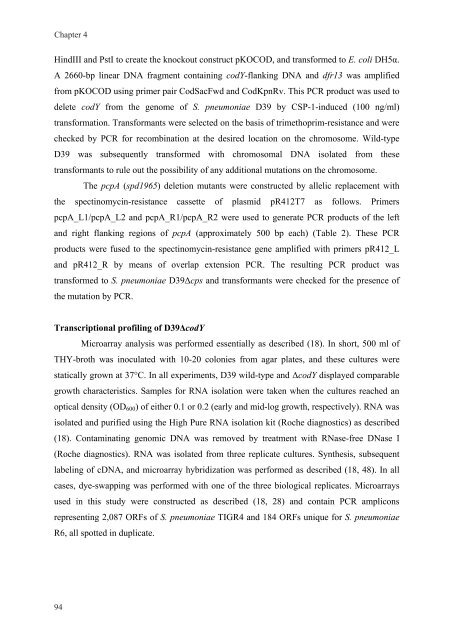Gene regulation in Streptococcus pneumoniae - RePub - Erasmus ...
Gene regulation in Streptococcus pneumoniae - RePub - Erasmus ...
Gene regulation in Streptococcus pneumoniae - RePub - Erasmus ...
Create successful ePaper yourself
Turn your PDF publications into a flip-book with our unique Google optimized e-Paper software.
Chapter 4<br />
H<strong>in</strong>dIII and PstI to create the knockout construct pKOCOD, and transformed to E. coli DH5α.<br />
A 2660-bp l<strong>in</strong>ear DNA fragment conta<strong>in</strong><strong>in</strong>g codY-flank<strong>in</strong>g DNA and dfr13 was amplified<br />
from pKOCOD us<strong>in</strong>g primer pair CodSacFwd and CodKpnRv. This PCR product was used to<br />
delete codY from the genome of S. <strong>pneumoniae</strong> D39 by CSP-1-<strong>in</strong>duced (100 ng/ml)<br />
transformation. Transformants were selected on the basis of trimethoprim-resistance and were<br />
checked by PCR for recomb<strong>in</strong>ation at the desired location on the chromosome. Wild-type<br />
D39 was subsequently transformed with chromosomal DNA isolated from these<br />
transformants to rule out the possibility of any additional mutations on the chromosome.<br />
94<br />
94<br />
The pcpA (spd1965) deletion mutants were constructed by allelic replacement with<br />
the spect<strong>in</strong>omyc<strong>in</strong>-resistance cassette of plasmid pR412T7 as follows. Primers<br />
pcpA_L1/pcpA_L2 and pcpA_R1/pcpA_R2 were used to generate PCR products of the left<br />
and right flank<strong>in</strong>g regions of pcpA (approximately 500 bp each) (Table 2). These PCR<br />
products were fused to the spect<strong>in</strong>omyc<strong>in</strong>-resistance gene amplified with primers pR412_L<br />
and pR412_R by means of overlap extension PCR. The result<strong>in</strong>g PCR product was<br />
transformed to S. <strong>pneumoniae</strong> D39Δcps and transformants were checked for the presence of<br />
the mutation by PCR.<br />
Transcriptional profil<strong>in</strong>g of D39ΔcodY<br />
Microarray analysis was performed essentially as described (18). In short, 500 ml of<br />
THY-broth was <strong>in</strong>oculated with 10-20 colonies from agar plates, and these cultures were<br />
statically grown at 37°C. In all experiments, D39 wild-type and ΔcodY displayed comparable<br />
growth characteristics. Samples for RNA isolation were taken when the cultures reached an<br />
optical density (OD600) of either 0.1 or 0.2 (early and mid-log growth, respectively). RNA was<br />
isolated and purified us<strong>in</strong>g the High Pure RNA isolation kit (Roche diagnostics) as described<br />
(18). Contam<strong>in</strong>at<strong>in</strong>g genomic DNA was removed by treatment with RNase-free DNase I<br />
(Roche diagnostics). RNA was isolated from three replicate cultures. Synthesis, subsequent<br />
label<strong>in</strong>g of cDNA, and microarray hybridization was performed as described (18, 48). In all<br />
cases, dye-swapp<strong>in</strong>g was performed with one of the three biological replicates. Microarrays<br />
used <strong>in</strong> this study were constructed as described (18, 28) and conta<strong>in</strong> PCR amplicons<br />
represent<strong>in</strong>g 2,087 ORFs of S. <strong>pneumoniae</strong> TIGR4 and 184 ORFs unique for S. <strong>pneumoniae</strong><br />
R6, all spotted <strong>in</strong> duplicate.

















